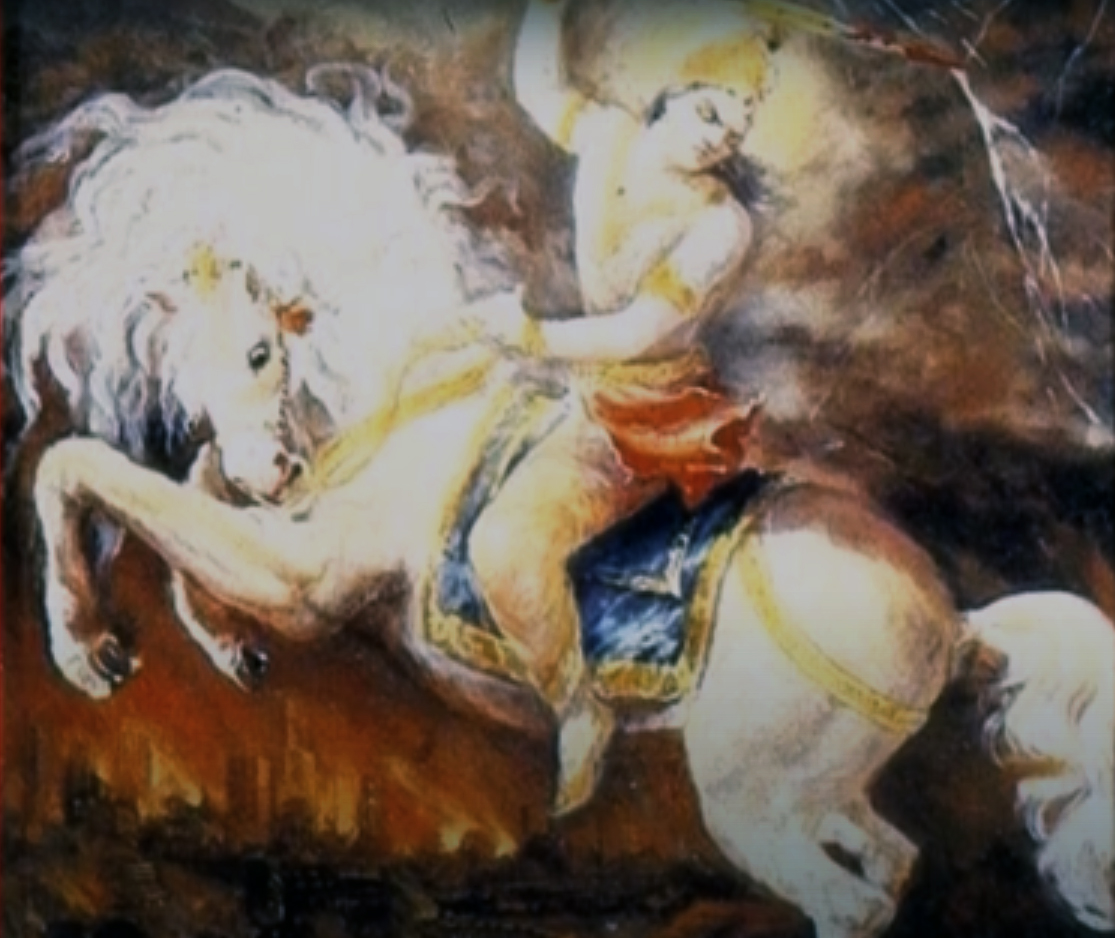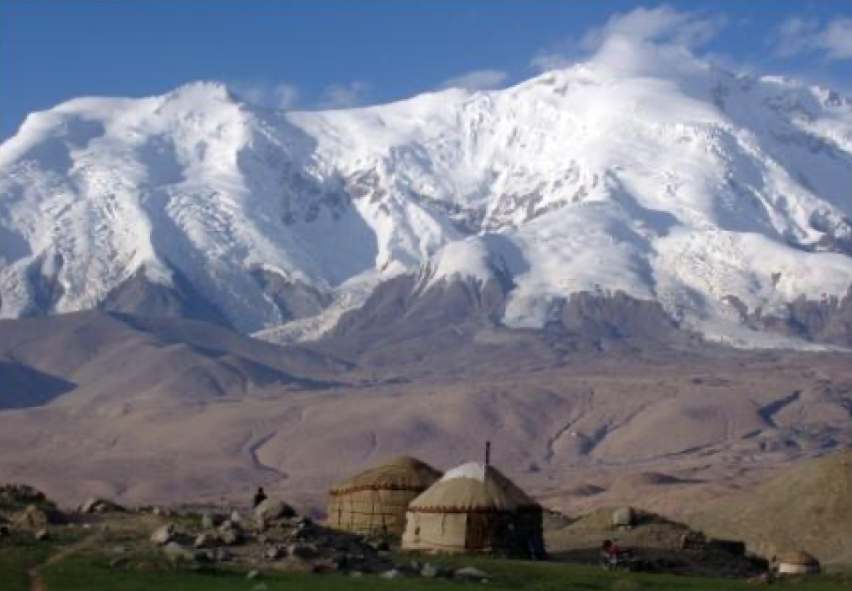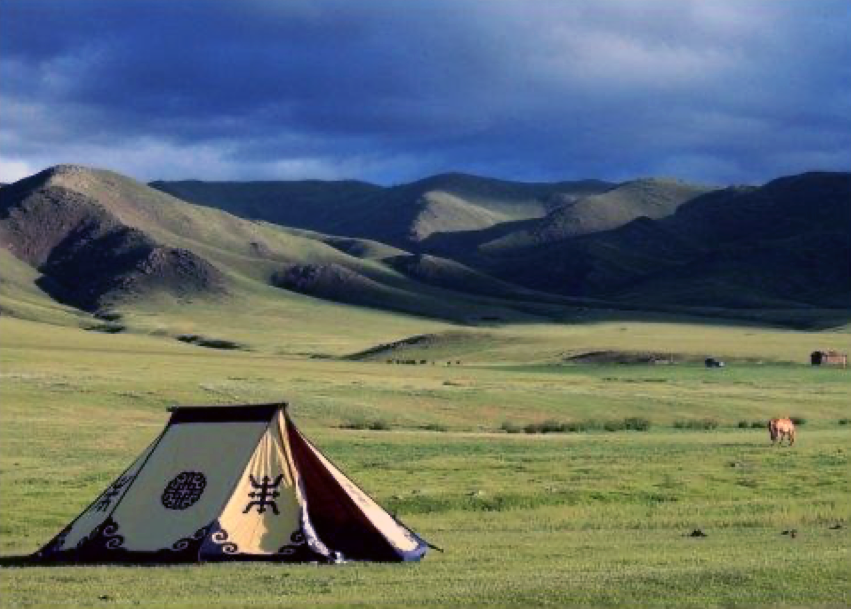by Eduardo Velasco

K A L K I (‘Destroyer of filth’).
If in the West we have inherited legends of Atlantis—a wealthy maritime trading state that, for its sins, was punished by the gods to perish beneath the sea—the East is also rife with mentions of lost lands. In the vast Buddhist regions of Central Asia, there are myths galore of underground cities and hidden valleys, such as Shambhala, where the ancient traditional and spiritual powers of the world would have retreated, waiting to manifest themselves in the final war between the spirits of good and the spirits of evil. The Mongols identify Shambhala with various valleys in southern Siberia, while in Altaic folklore, the gateway to the secret city is hidden in the Altai mountain range’s Mount Beluja, where legend has it that Genghis Khan was buried.
The Kalachakra, a Tibetan Buddhist tantric scripture with strong Hindu influences, states that when the world degenerates into a maelstrom of war and greed, out of Shambhala will emerge Kalki (‘white horse’, or ‘destroyer of filth’), a kind of messiah who will form an army and fight the demonic forces, killing by the millions the ‘barbarians’ and the ‘thieves who have usurped the royal power’. Gathering all the Brahmins of the world, he would find a new race to populate the golden age to come. In their shamanic past, the Turkic-Mongol peoples spoke of Ergekenon, an isolated valley supposedly located in the Altai, where their ancestors were imprisoned for four centuries until a blacksmith succeeded in melting the barrier that enclosed them. The myth of Ergenekon would later be used strategically by Turkish nationalism to promote pan-Turanianism.
From China, tradition had it that Lao Tse (‘wise old man’, the founder of Taoism) rode out of the country on a white buffalo to the West, i.e. to Central Asia, perhaps to the Kunlun Shan Mountains, where the sources of the Yellow River were located, a place considered holy by monks and hermits, where the air was pure and energising, where healing herbs grew and huge glaciers advanced, where schools of martial arts were born and in whose rivers long-lived fish lived. Taoist folklore explained that in this kind of spiritual Eden, in the ‘mountain at the centre of the world’, royal men found the drink of immortality in ancient times, and that King Mu (a millennium b.c.e.) found there the jade palace of the Yellow Emperor, the founder of Chinese civilisation. Mythologically speaking, the mountain range connected Earth with Heaven and somewhere in its bosom stood a jade palace where Xiwangmu, the ‘Queen Mother of the West’, dwelled. Like an Eastern version of the Greek myth of the garden of the Hesperides, a huge tree grew there, bearing peaches of immortality every three thousand years.
The Kunlun Shan mountain range.
In the West, the interior of Eurasia was also viewed through a prism of legend. In Histories, Herodotus speaks of a place ‘to the north-east’, beyond the Sea of Hyrcania (the Caspian) and the Scythians, where there are vast quantities of gold guarded by griffins. Buran (a strong winter wind from the north, equivalent to the Greek Boreas), blew there strongly from a mountainous cavern in the so-called Zungaria Gate, which separates Uiguristan (also called Chinese Turkestan or Xingjiang) from the rest of Central Asia. Beyond this domain was the ‘land of the Hyperboreans’, whose territory reached the sea (probably the Arctic Ocean). In the Byzantine myths, Alexander the Great found no other solution to the hordes of ‘Gog and Magog’ (barbarians from the continental interior, sometimes assimilated to the Scythians and destined to fall upon the rest of the world in the future) than to contain them with a wall of iron or adamantium. This is probably the Caspian Gates in southern Russia, where centuries later an army of Slavs and Vikings would annihilate the Khazar kingdom and found the first Russian state. The metaphorical content of the construction of the Caspian Gates was served—especially since, in Central Asian folklore, an ‘iron gate in a lake’ or a ‘hole in a mountain’ is considered the origin of the winds. After the ill-fated Macedonian campaigns in northern India, a Hellenistic story reached the West and circulated the idea that deep in Central Asia there was a valley carpeted with diamonds and patrolled by birds of prey and ‘deadly looking’ serpents. At the time of the silk trade, Rome knew of the existence of the Beings, a tall, long-lived and healthy people (possibly the Tocari) located in Serica, the ‘land of silk’, which would correspond to Uyghuristan. These myths and rumours somehow embodied Europe’s desire not to lose its connection with the East.
In medieval times, Rome, Byzantium and the Crusader states alike spoke of the kingdom of Prester John, a monarch who maintained order in the lands of Gog and Magog by ruling over a Christian country isolated between Muslim and ‘pagan’ (read Buddhist, Hindu and shamanistic and animistic ancestral religions) domains. Gnostic traditions considered that the Magi came from this country, where the Holy Grail, obtained by Parzival in Monsalvat and carried to the Great East in ships with white sails and red crosses, was to be found along with other holy relics of Christianity… ‘John’ was probably a corruption of ‘jan’ or khan: the title of the Tatar kings. The character in question was probably a Nestorian khan-bishop of Mongol origin eager to forge closer ties with the West, but the situation soon became enveloped in symbols and archetypes in the collective European imagination. Marco Polo, who could not be missing in this writing, would place Gog and Magog north of Cathay (China), i.e. in Mongolia or Siberia. In China itself, the imperial authorities did something similar to Alexander the Great, writing off the Heartland as impossible and settling for erecting the Great Wall to protect the kingdom from barbarian incursions from the North.
Still in the 19th century, Russian settlers in Siberia, men and women of outstanding human qualities in every sense, had the idea of Belovodye, a mythical place of ‘white waters’ in eastern Siberia, which played the role of the Promised Land in their religious imagination and probably had an important influence on the flow of ethnically European populations to the East, establishing colonies ever closer to the Sea of Japan and the borders with China and Mongolia. As Russia conquered Central Asia, Nikolai Fyodorovich Fyodorov, founder of the Russian philosophical trend of cosmism, located Shambhala in the Pamir, present-day Tajikistan. Central Asia would become increasingly popular in the West thanks to Jules Verne’s Michael Strogoff, the incipient geopolitical science, Ferdinand Ossendowsky’s Beasts, Men and Gods and the rise of occult currents that idealised Central Asia as a sanctuary of tradition and wisdom. In the 1920s, the Russian painter, archaeologist and esotericist Nikolai Roerich also did his bit by describing an extraordinary expedition throughout Central Asia, including his visits to more than fifty monasteries and his encounters with Buddhist lamas.
Mongolia.
As can be seen, the more recondite areas of Central Asia were seen as a source of mystery, fantasy and uncertainty by the societies that gathered their influence. They were also seen as a hornet’s nest of men and animals, which could be diked but should not be stirred. All the myths we have seen agree in presenting the heart of Eurasia as a place, to say the least, interesting and worth visiting for the brave and the noble. The present article will deal with this vast space inhabited by questions and infinite possibilities yet to be unveiled, a potential new world, a huge, closed, inaccessible, impregnable, jealously traditional fortress, folded in on itself in countless valleys, mountains, plains, forests, steppes and deserts, which could not be conquered by Alexander the Great, nor by Rome, nor by Byzantium, nor by the Chinese emperors, nor by the Polish-Lithuanian Commonwealth, nor by the Portuguese Jesuits, nor by Napoleon, nor by the British Empire, nor by Hitler, nor by Japan, nor by the mafia oligarchs of the ex-Soviet space, nor by the multinationals and banks of capitalist-neoliberal globalisation—in the long run not even by the Asian khans or the terrible Soviet Bolshevism—but only by two extraordinary peoples: the Vikings and the Cossacks, who, like Alexander the Great before them, brought Greek culture (Cyrillic characters, Byzantine heritage) to the heart of Asia.
Since the dawn of history, whoever possesses the Heartland moves in it like a fish in water, for it is an ocean of land, but whoever does not possess it will crash against its walls again and again, and can only content himself with besieging it…

